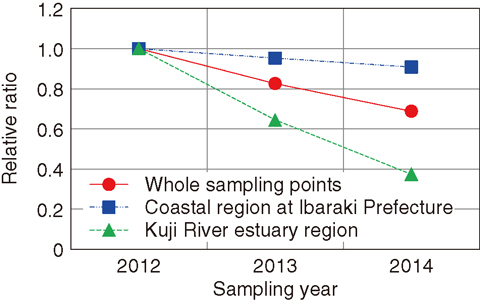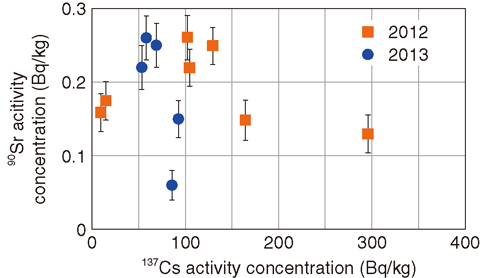
Fig.1-12 Time series of 137Cs concentrations in seabed sediments off the Ibaraki coast

Fig.1-13 Time series of 137Cs concentrations in seabed sediments

Fig.1-14 The relationship between 137Cs and 90Sr concentrations in seabed sediments
Various radionuclides were discharged into the environment by the accident at the TEPCO’s Fukushima Daiichi NPS (1F). We have continuously investigated the radioactivity concentrations in seabed sediment, seawater, and marine organisms on the Ibaraki coast from before the accident to the present time, and confirmed that the concentrations were influenced by the accident at 1F. Therefore, to estimate the influence in detail, we studied the radioactivity concentrations of cesium-134 (134Cs), cesium-137 (137Cs), strontium-90 (90Sr), and plutonium (238Pu and 239,240Pu) in 51 dried seabed sediment samples collected in the coastal regions of Ibaraki Prefecture.
We collected seabed sediment at the same points for three years during May-July 2012, June-July 2013, and May-July in 2014 and determined 134Cs and 137Cs concentrations. Then, 90Sr and Pu were analyzed using seabed sediments with higher 137Cs concentrations.
Fig.1-12 shows time series of 137Cs concentrations over three years. Most concentrations decreased overall with time. The highest 137Cs concentration in 2012 was approximately 100 times higher than the values (about 1 Bq/kg) observed before the accident but decreased to several tens of times higher than those values in 2013 and 2014. Some 137Cs concentrations decreased to the level they had had prior to the accident in 2014. We investigated the decreasing tendency of 137Cs concentrations for three years and found that there were different tendencies among the sampling points, especially between the coastal region (30 points) at Ibaraki Prefecture and the Kuji River estuary region (21 points), as shown in Fig.1-13. We suggest that the difference could have been caused by influence of geographical features and particle size in the sediment and so on.
The 90Sr-concentrations ranged from ND (not detected) to 0.26 Bq/kg in 2012 and 2013. Moreover, we found no correlation between 137Cs and 90Sr concentrations in this study (Fig.1-14). Therefore it seemed that the influence of 90Sr concentration was smaller than those of the 134Cs and 137Cs concentrations because of the accident in the seabed sediments off the Ibaraki coast. Moreover, Pu concentrations were very low and no influence of the accident was recognized in this study.
We will continue to investigate the influence of the accident on environmental monitoring in the regions.